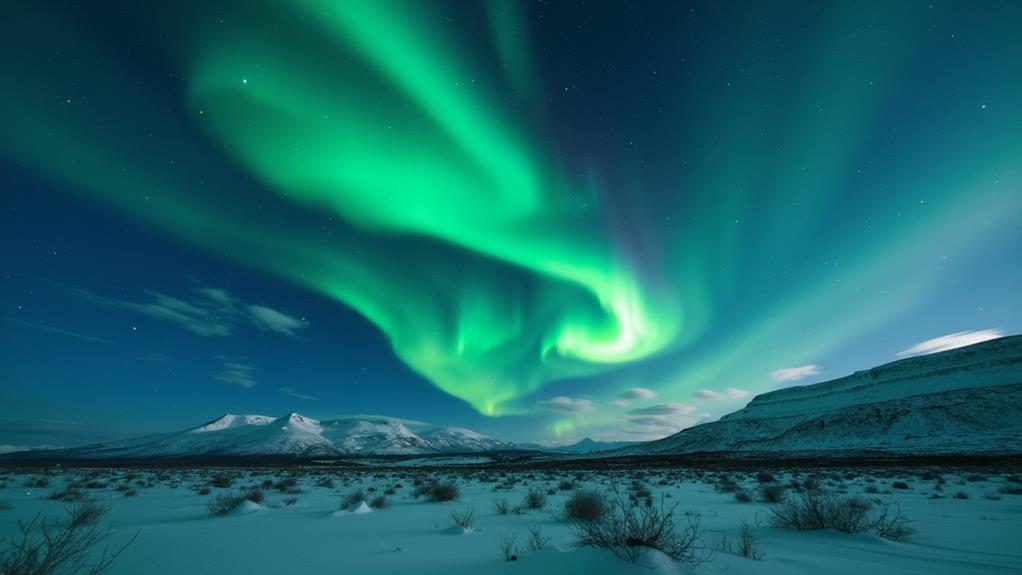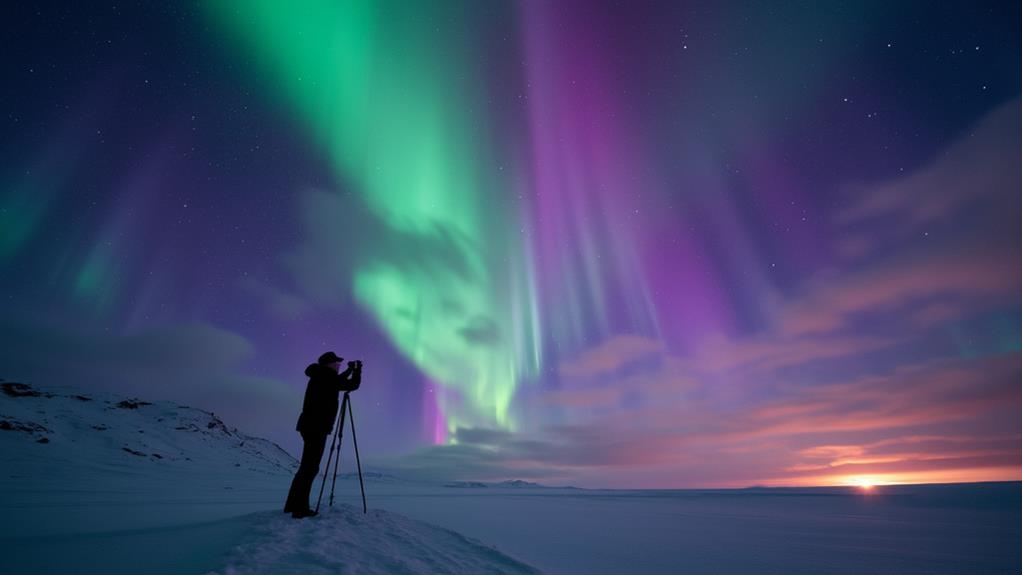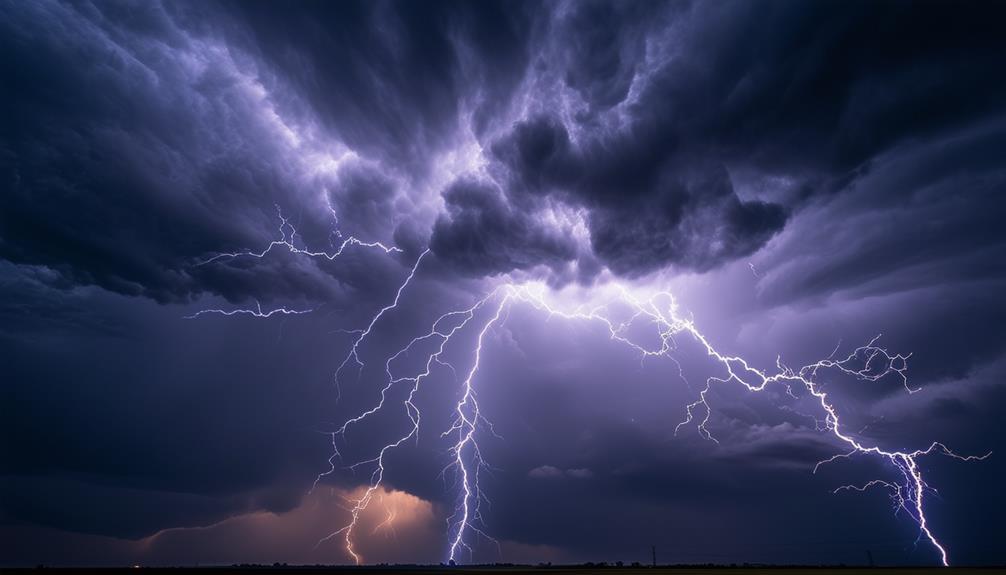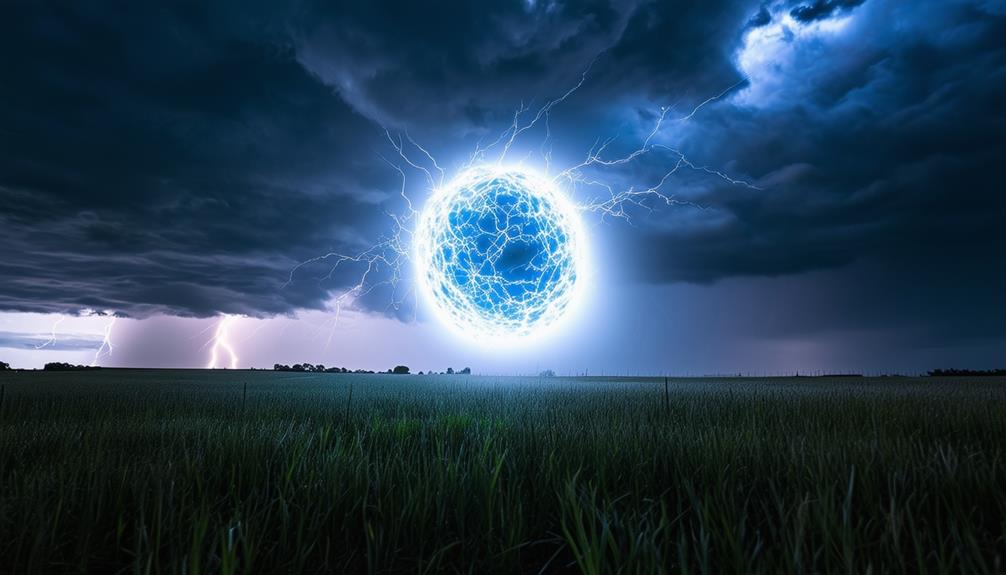Green Lightning: How Rare Is It and Where Can You See It?
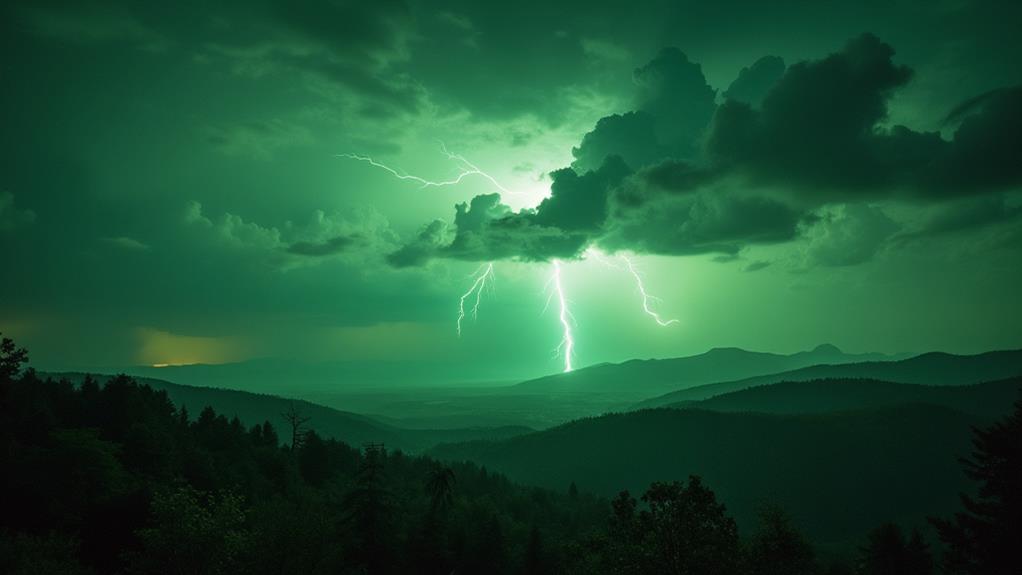
When you think of lightning, you likely envision the familiar white or blue streaks illuminating the sky. However, green lightning is an entirely different and rare phenomenon. This unusual event occurs under specific atmospheric conditions and has been documented in regions such as Oklahoma and South Africa. The green coloration arises from the excitation of oxygen and nitrogen molecules during intense storms, often enhanced by high humidity and ice crystals. So, how frequently does this captivating event occur, and what conditions must align for you to witness it? Let's explore the factors and documented sightings that make green lightning a fascinating subject.
Understanding Green Lightning
Green lightning, a rare and captivating phenomenon, captures the imagination with its distinct greenish hue. Witnessing this atmospheric event is truly exceptional and typically occurs during severe weather conditions such as thunderstorms and tornadoes. Its ethereal and otherworldly appearance sets it apart from more common types of lightning.
This phenomenon arises under specific atmospheric conditions. High humidity, temperature variations, and the presence of ice crystals within storm clouds all contribute to the occurrence of green lightning. During a lightning strike, the excitation of oxygen and nitrogen molecules can result in the emission of light at wavelengths that produce a greenish tint. This unique coloration distinguishes green lightning from other lightning forms.
Observers often describe green lightning as otherworldly, enhancing its mystique. Notable instances have been documented during significant weather events, including the Chaiten volcano eruption in May 2008 and thunderstorms in Oklahoma City and New Zealand. Each sighting adds to the allure and fascination surrounding this rare atmospheric event, making it an enthralling subject for weather enthusiasts and scientists alike.
Causes of Green Lightning
Understanding the distinctive color of green lightning involves examining specific atmospheric conditions. Green lightning is often observed during severe weather events like thunderstorms and tornadoes, which create the perfect atmospheric conditions—high humidity and specific temperature ranges—that enhance the visibility of this rare phenomenon.
When lightning strikes, it excites atmospheric gases, particularly oxygen and nitrogen. This excitation process causes these gases to emit light at specific wavelengths. In the case of green lightning, oxygen emissions produce a greenish hue under the right conditions. Ice crystals within storm clouds also play a significant role by reflecting and scattering the light, making the green color more apparent.
Witnessing green lightning typically requires being in the right place at the right time, with favorable viewing angles. Its flashes are brief, often lasting only a few seconds, but their intensity can vary, displaying a range of shades from teal to green. Notable occurrences have been reported during significant weather events, such as the Chaiten volcano eruption in 2008 and thunderstorms in Oklahoma City.
Rarity and Occurrence

Observing green lightning is a rare phenomenon, primarily linked to severe weather events like thunderstorms and snowstorms. The rarity of green lightning is due to the specific atmospheric conditions required for its visibility, including a mix of deep thunderstorm clouds, varying temperatures, high humidity, and ice crystals within the clouds.
Documented sightings of green lightning are limited, which adds to its elusive nature. Notable instances have been observed in places like Oklahoma City, during the Kaikoura earthquake in New Zealand, and the Chaiten volcano eruption in 2008. Green lightning flashes last only a few seconds and can vary in color intensity from teal to magenta, making it challenging to catch a glimpse.
Witnesses often miss seeing green lightning due to its infrequency. Personal accounts and community-shared experiences play an essential role in understanding this atmospheric phenomenon. When green lightning is observed, it usually occurs during the most intense parts of storms, making these sightings even more special and rare. Keep an eye out during severe weather events; you might be one of the lucky few to witness this extraordinary display.
Historical Sightings
Green lightning has been documented during extraordinary events like the Chaiten volcano eruption in 2008 and the Kaikoura earthquake in New Zealand. Severe thunderstorms in Oklahoma City and South Africa have also reported this rare phenomenon. Witness accounts from these extreme weather events highlight its rarity and add to its allure.
Notable Green Lightning Events
Green lightning has captivated observers during some of history's most intense atmospheric events. Notable sightings have been reported under unique conditions, such as during the Kaikoura earthquake in New Zealand in 2016. Here, storm clouds and seismic activity combined to create the perfect setting for this rare spectacle. Similarly, the eruption of the Chaiten volcano in May 2008 offered a dramatic display of green lightning as volcanic ash heightened atmospheric tension.
Oklahoma City has also witnessed green lightning during severe thunderstorms, particularly when tornado conditions prevail. These sightings underscore the link between green lightning and turbulent weather patterns. Historical accounts in Kansas and South Africa describe green lightning appearing in conjunction with deep thunderstorm clouds, adding to its mystique.
Reports consistently highlight the ethereal quality and vivid green hue of this lightning, often noting its brief yet mesmerizing presence during intense storm conditions. Witnesses describe the phenomenon as a fleeting glimpse into nature's raw power, leaving a lasting impression. Regardless of being observed amidst volcanic eruptions or turbulent thunderstorms, green lightning remains an enchanting and rare occurrence that continues to intrigue and astonish.
Documented Global Occurrences
Green lightning is a rare and fascinating phenomenon often documented during severe weather events. Notable instances include the Chaitén volcano eruption in May 2008 and the Kaikoura earthquake in New Zealand, which underscore the unique atmospheric conditions required for green lightning.
Historically, sightings of green lightning have been sporadic, primarily associated with thunderstorms in locations such as Oklahoma City, Kansas, and South Africa. These regions, known for intense storm activity, provide the ideal conditions for such occurrences. Residents have reported seeing green flashes during severe weather, especially during cyclones and significant storm events.
The rarity of green lightning is highlighted by these documented sightings, which often require specific conditions like favorable viewing angles and the intensity of the storm. Unlike the more common white or blue-white lightning, green lightning stands out for its infrequency and mysterious allure.
The documented occurrences of green lightning during extreme weather events make it a subject of intrigue and wonder for meteorologists and weather enthusiasts alike.
Witness Accounts and Reports
Witness accounts provide a fascinating glimpse into the rare phenomenon of green lightning, often observed during significant weather events like thunderstorms and tornadoes. Notable occurrences have been reported in regions such as Kansas, Oklahoma, South Africa, and during the 2016 Kaikoura earthquake in New Zealand, where green flashes were seen amidst storm clouds.
Consider these intriguing instances:
- Kansas and Oklahoma: Residents have reported green lightning during intense thunderstorms and tornadoes.
- Kaikoura Earthquake, New Zealand (2016): Witnesses observed green flashes during stormy conditions following the earthquake.
- Chaiten Volcano Eruption, Chile (2008): Observers saw green lightning amidst volcanic ash conditions.
- Darwin, Australia: Locals reported green lightning during recent severe storms.
- Historical Accounts: Numerous reports highlight green lightning's rarity compared to common white or blue-white lightning, adding to its mystique.
These witness accounts not only validate the existence of this rare phenomenon but also fuel public curiosity. Observing green lightning, especially during significant weather events, offers a unique and memorable experience.
Ongoing Research
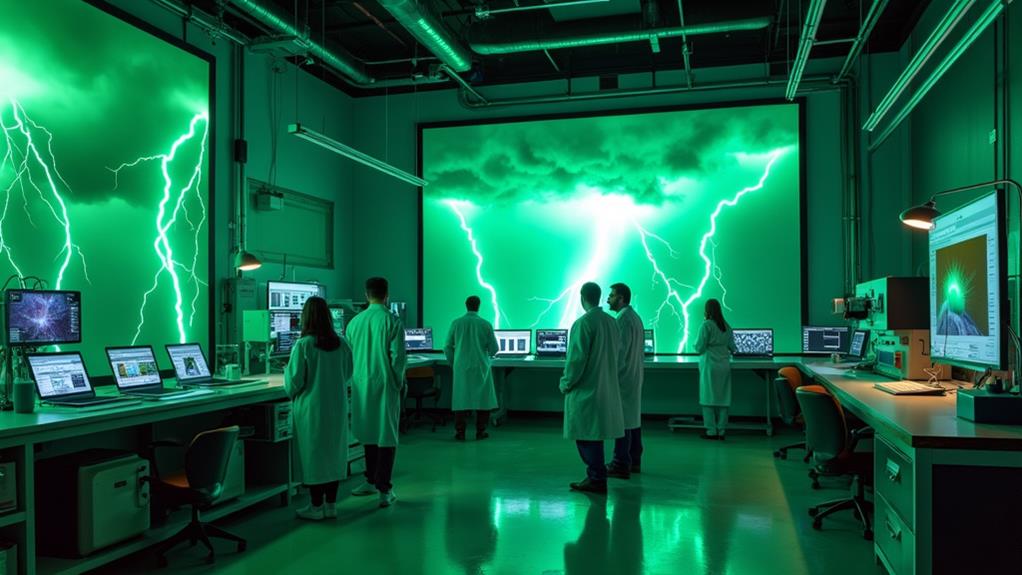
The latest research into green lightning combines theoretical modeling with real-world observations. Scientists are investigating how atmospheric conditions and excited molecules contribute to its rare appearance, while online communities share experiences and sightings. These combined efforts are driving a deeper understanding and increasing public interest in this elusive phenomenon.
Theoretical Modeling Advances
Scientists predict the elusive phenomenon of green lightning using advanced theoretical modeling to replicate the precise atmospheric conditions necessary for its occurrence. By simulating these conditions, researchers can analyze the complex interactions between charged particles and gas compositions that contribute to the rare green hue of lightning.
To capture this phenomenon, scientists focus on several key environmental factors:
- Humidity: Higher moisture levels can influence the visibility of green lightning.
- Temperature Variations: Fluctuations in temperature affect the electrical discharge processes.
- Ice Crystals: The presence of ice can alter the color of lightning.
- Gas Composition: Specific gases in the atmosphere contribute to the green hue.
- Charged Particle Interactions: The interplay between charged particles is essential for green lightning formation.
Ongoing research involves collaborative studies to refine the understanding of these electrical discharge processes and their relationship with other lightning phenomena. By pairing field observations with theoretical models, scientists aim to improve their predictive capabilities for future storm events. This approach not only helps in anticipating green lightning but also broadens our knowledge of atmospheric science and the factors that drive such rare occurrences.
Community Shared Experiences
Green lightning has captivated both scientists and the general public due to its rare and striking appearance. It requires specific atmospheric conditions often linked to severe weather events like thunderstorms and tornadoes, making sightings infrequent. However, community engagement through social media and online forums has facilitated the sharing of personal experiences and photographs of green lightning, enhancing public interest.
By participating in these online communities, you can connect with others who have witnessed this phenomenon, share your observations, and learn about notable instances such as the Chaiten volcano eruption in 2008 or thunderstorms in regions like New Zealand and Oklahoma. These shared experiences contribute to ongoing research, as scientists use real-world data to understand the atmospheric conditions that enable green lightning.
Your contributions help build a collective knowledge base, promoting educational discussions within weather communities. This increased curiosity and awareness drive more thorough investigations into green lightning, fostering a broader understanding of its elusive nature. By engaging with these communities, you play a crucial role in unraveling the mysteries of green lightning and its atmospheric interactions.
Safety Tips
When encountering green lightning, it is essential to follow standard lightning safety protocols, as green lightning carries the same risks as conventional lightning. Additionally, green lightning can indicate severe weather conditions such as tornadoes, underscoring the importance of vigilance.
To stay safe during green lightning events, adhere to these guidelines:
- Seek Shelter Indoors: Move indoors or to a hard-topped vehicle when thunderstorms are present, especially if you observe green lightning.
- Avoid Open Areas: Keep away from open fields, tall objects, and metal structures to minimize the risk of lightning strikes.
- Use Lightning Detectors: Employ devices like the Robic Strike Alert to receive timely warnings and enhance your preparedness during severe weather.
- Stay Informed: Monitor weather alerts and updates from reliable sources to understand the risks associated with green lightning and thunderstorms.
- Emergency Preparedness: Have an emergency kit and a plan ready for responding to severe weather events, including those involving green lightning.

